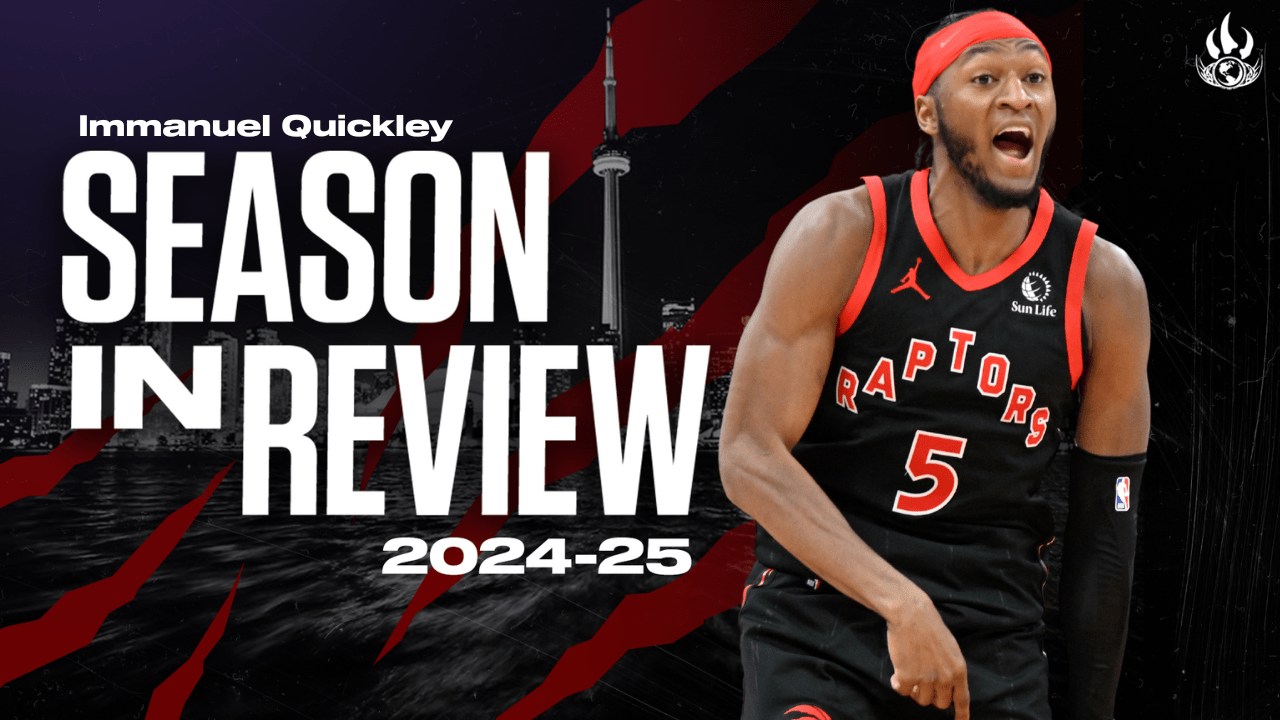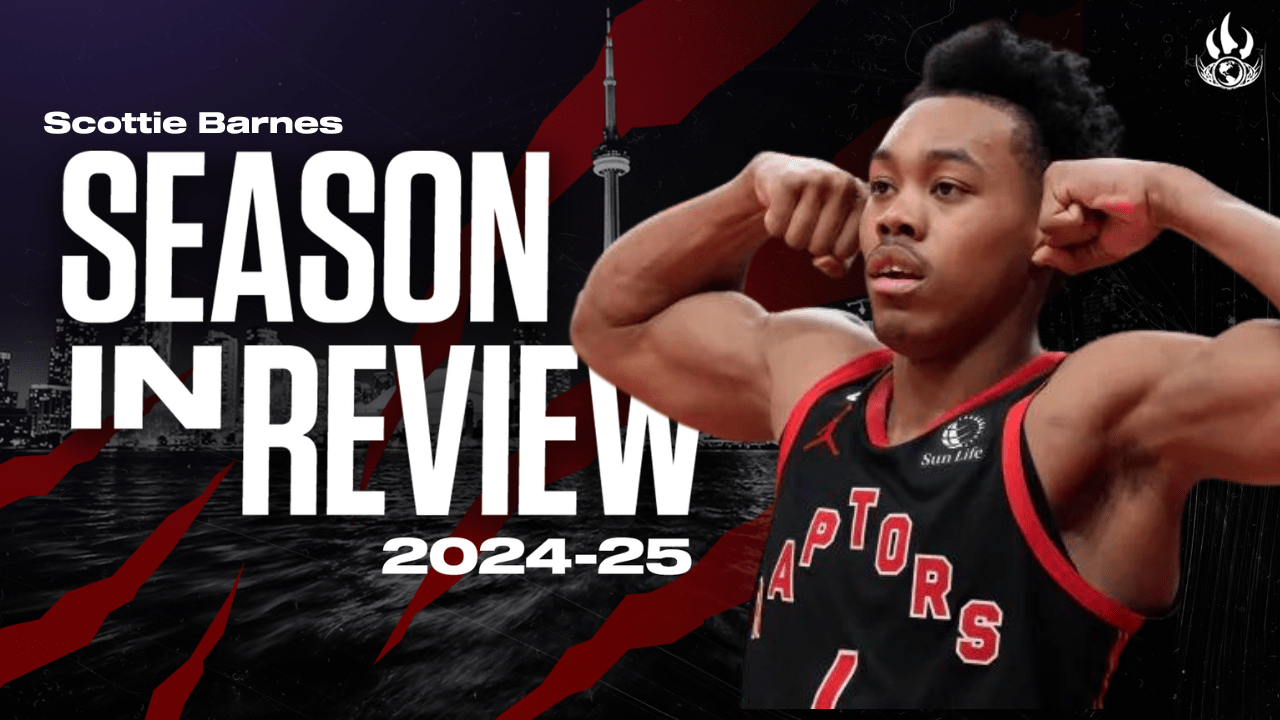The following is part of Raptors Republic’s series of pieces reviewing the season for the Toronto Raptors. You can find all the pieces in the series here.
Whether it’s describing a teenager learning to drive a manual car or talking about Immanuel Quickley’s 2024-25 season, the words “start” and “stop” are going to be mentioned.
After signing a five-year, $175 million deal last summer to be the Toronto Raptors lead guard of the future, the 25-year-old’s first “full” season with the team was quickly (pardon the pun) derailed by a smattering of injuries.
He played just 33 games in his fifth year, averaging 17.1 points, 3.5 rebounds and 5.8 assists (30th in the NBA) on 42.0/ 36.8/ 86.7 per cent shooting splits. Unfortunately, absences have been a common trend throughout Quickley’s tenure north of the border. In a season and a half with Toronto, he’s missed 62 games while appearing in 71. (Granted, a handful of those absences were due to personal reasons last year, and then the team opted to routinely rest him down the stretch of this season.)
To Quickley’s credit, his first start-to-finish campaign with the Raptors did see him hit season-long career highs in scoring and assists, along with attempts from the field (13.3), beyond the arc (6.8) and free throw line (3.9).
A silver lining of sorts, for a season lost to injuries.
Quickley’s stream of setbacks began as early as the Raptors’ season opener when he lasted 14 minutes before leaving due to a pelvic contusion and missing eight consecutive games. He then returned for all of two appearances before an elbow ligament tear sidelined him for 22 more games, which led to his second comeback that lasted six contests — albeit starting with a stellar 21-point, 15-assist showing against the Nets — before yet another injury (hip strain) had him M.I.A. for two more weeks.
His longest uninterrupted stretch of play spanned a not-so-whopping 12 games between February and March. In other words, for a regular season that lasted nearly six months, Quickley was afforded a single unimpeded 30-day stretch without circumstances taking him off the floor.
It was hardly a campaign that the Raptors organization, fans or Quickley himself would have wanted. And the fact that when he did play, his game was generally as advertised, only made all the interruptions that much more frustrating.
During the one month he got to play continuously, Quickley’s production across the board was higher than his season averages. Both his offensive volume and efficiency were up, and there was a palpable difference in how intentional he was as a scorer, initiator and defender.
And before someone brings it up, no, his production wasn’t merely a result of the Raptors’ less-than-fierce schedule down the stretch. Toronto went 5-7 during that span, with eight of those 12 games coming against playoff teams. Quickley finished with a positive plus-minus in six of those contests, and even in double-digit losses to a pair of 60-plus win teams in the Thunder and Celtics, he ended a minus-two and minus-three, respectively.
| Stat category | Quickley’s season averages (33 games) | Averages from Feb. 7 – Mar. 7 (12 games) |
| Points | 17.1 | 19.5 |
| Rebounds | 3.5 | 4.5 |
| Assists | 5.8 | 5.3 |
| True shooting | 57% | 59.7 |
| Net rating | -1.6 | +4.4 |
The point is, he showed positive flashes when health allowed. And although the lead guard experiment is still very much ongoing, there was progression. Aside from his raw assist totals, he also hit career-highs for assist percentage (32.0) and assist-to-turnover ratio (3.29), both of which were tops amongst the Raptors despite averaging roughly the same number of touches and time-per-touch as 2023-24. All the while, Quickley was fifth on the roster for points generated by assists, and likely would’ve led the roster, had it not been for injuries. He generated 34 fewer points off his passes than Davion Mitchell, who ranked fourth, and Quickley did so in 11 fewer games.
The Kentucky product was especially effective as a pick-and-roll ball handler. While some of that could be credited to the effectiveness of Jakob Poeltl as a screener, it doesn’t explain it all, considering the Raptors as a whole ranked bottom-five in generating points of PNRs while Quickley was top 50 in the NBA (70th percentile).
So, even though a good bit of Quickley’s playmaking was only visible in flashes and done through more rudimentary processes than those of other elite playmakers, he’s not nearly as far along in his PG development journey as most of those guys. As a possibly disgruntled Greek superstar in Milwaukee once put it, “it’s steps to success.”
How much those brief spurts translate into a full season, especially with the addition of Brandon Ingram, is still to be determined. Which goes back to the frustration. Quickley’s been a member of the Raptors for over a full calendar year, and the team is still primarily relying on his hypothetical fit next to the rest of the core, namely Scottie Barnes, rather than working off any substantive amount of real data. So, by no means was his season a total failure (you hear that Giannis?). It just wasn’t anything close to a success either. Let’s call it disappointing.
For what it’s worth, I still think Quickley showed enough in 2024-25 for fans to afford him a bit of patience, or at least be cautiously optimistic heading into the second year of his deal — even if he’s left some questions unanswered.
In theory (and in very limited practice), his abilities solve problems for the Raptors. Quickley remains one of Toronto’s most effective high-volume threats from beyond the arc, for a team that was woeful in producing points from distance. Of the seven Raptors to average at least four 3-point shots per game this season, he ranked first in attempts and third in percentage, only behind Jamison Battle and Ochai Agbaji. He was also Toronto’s most impactful pull-up shooter in 2024-25. Another area of weakness for the team, which ranked second-last in the league for overall pull-up production and dead last in pull-up makes from distance. Meanwhile, Quickley was 35th in the NBA for average points produced on such shots and 25th in makes from beyond the arc.
All of which makes him sound like a damn good off-ball player next to Barnes (and Ingram) next season. A player who can work around the team’s star forwards and finish plays at a positive clip is desirable. By all accounts, Quickley is a much more efficient play finisher when sharing the floor with Barnes. And with Ingram in the mix next year, who would’ve ranked second on the team for touches based on his numbers in New Orleans, Quickley’s on-ball reps are presumably only going to go down. So, it’s worth having a strong off-ball option who can maximize his looks, especially one of Quickley’s calibre, on a team that sorely needs the kind of production he can provide from beyond the arc.

But when the ball is in his hands (and it will be), the question remains: can he do true lead guard stuff consistently? Because, even if his average touches go down, the ball will still stick with Quickley if current numbers are any indication. Despite averaging the third-most touches on Toronto, he led the team in dribbles and seconds per touch. Even in Darko Rajakovic’s movement-heavy offence, Quickley’s been empowered to keep the rock and figure things out.
When those opportunities come around next season, will Quickley start creating advantages for himself and others, or continue to primarily find success within already advantageous positions?
For instance, will he be able to put the ball on the floor and go to work like many of the truly elite ball-handlers around the league? Or, will he fall back into a reliance on Barnes doubles, Poeltl screens or RJ Barrett drives to make plays? Again, pulling on those levers isn’t a bad thing, but self-creation, especially from the team’s lead guard, is important.
So far, he’s not been a reliable isolation threat while on the Raptors, not an efficient one anyway. Of the seven players on the roster to total over 10 iso possessions this season, Quickley ranked last in field goal percentage (33.3). A possible fix for that is for him to tap into his pull-up shooting much more often. A skill routinely leveraged by the league’s most productive iso-scorers, especially other floor generals. Of the six guards to rank top 10 in isolation points per game, four also rank top 10 in points generated from pull-up jumpers. There’s a boatload of reasons why folks have urged Quickley to let it fly more liberally, and why he’ll be empowered to do so — make this one more.
At the end of the day, Quickley might just be a stellar off-ball guard. But he’s currently paid to be more — single-handedly accounting for over 20 per cent of the salary cap — and the Raptors envisioned a higher ceiling for him when they acquired him.
Great teams thrive on offensive diversity and the ability to counter adjustments. Stephen Curry is undoubtedly the greatest off-ball mover/shooter ever, but even he’ll start possessions with the ball to avoid deny-ball defences. Jamal Murray plays next to one of the best playmaking bigs in NBA history, but the Nuggets will still deploy Nikola Jokic as a decoy for Kitchener’s finest to let off one of his many playoff daggers (just as the Los Angeles Lakers).
The Raptors will want that optionality with Quickley as they look to turn the corner next season and find more ways to leverage the talents of Barnes and company. His combination of speed, twitchiness and outside touch is like that of some of the league’s top floor generals while being completely unique amongst his teammates in Toronto.
Ultimately, while 2024-25 didn’t do a ton to prove Quickley’s potential to reach that level, it also didn’t slam the door shut on it either. The hope is that with a bit of grease on the wheels and a softer touch on the clutch, the start-and-stop nature of the guard’s tenure might finally be over — and with a bit of consistency, we can enjoy a much smoother ride ahead.


